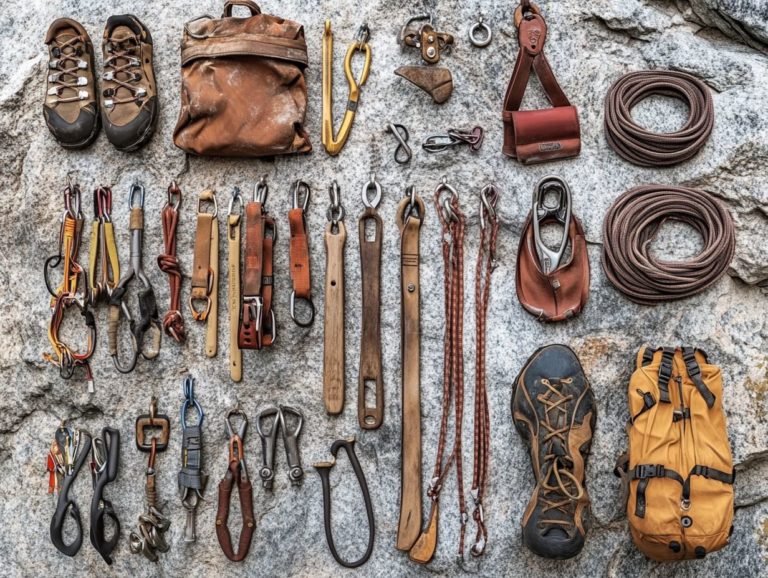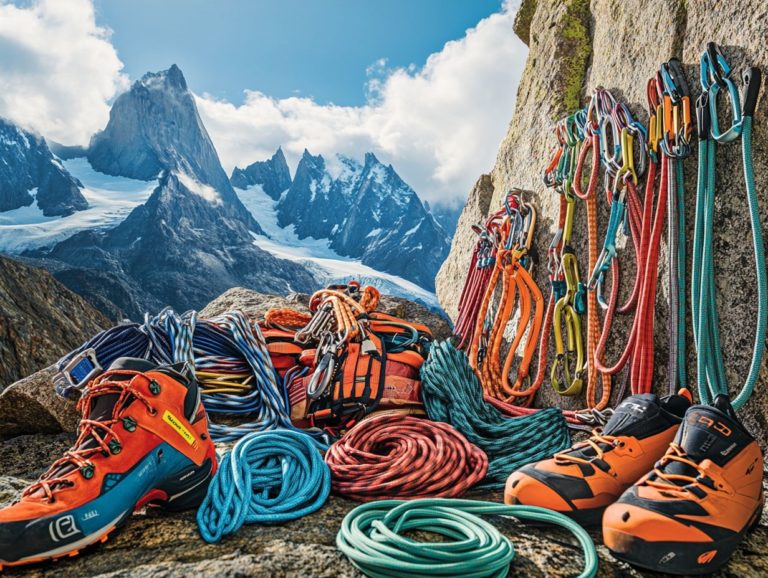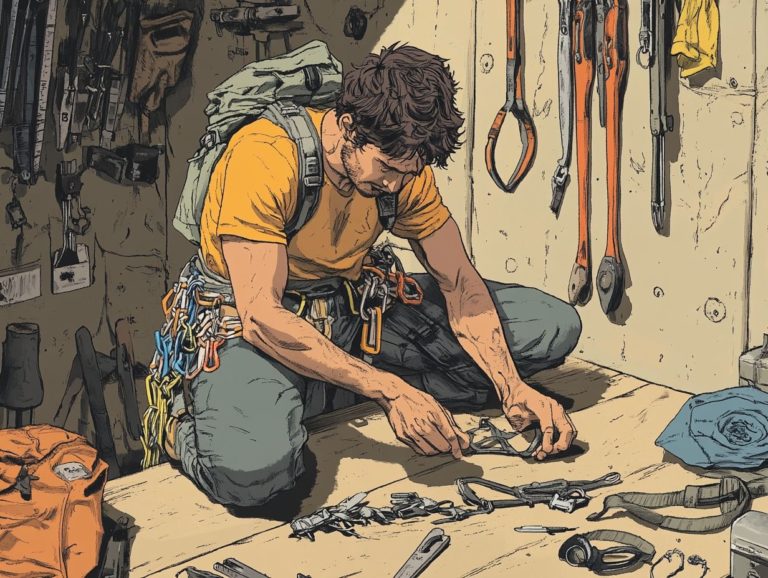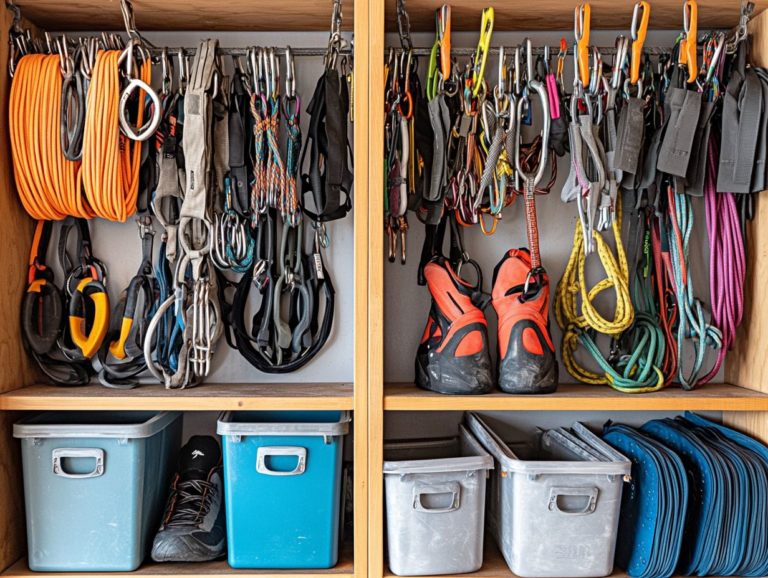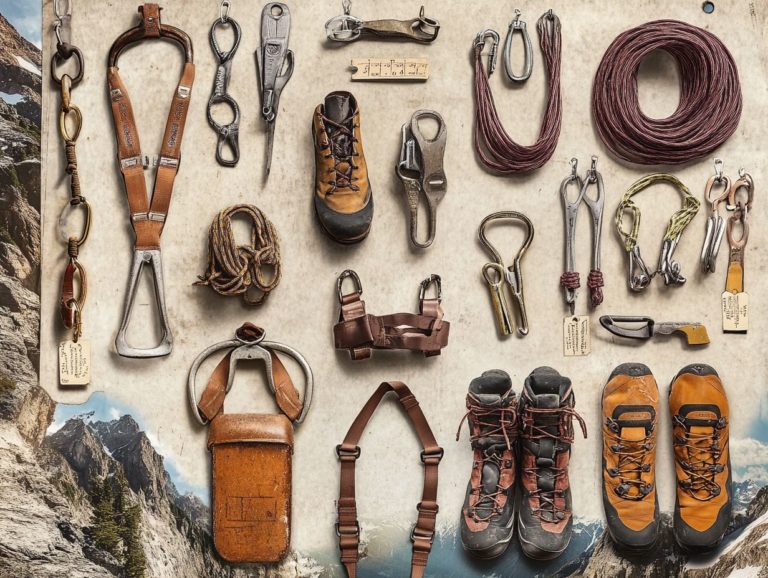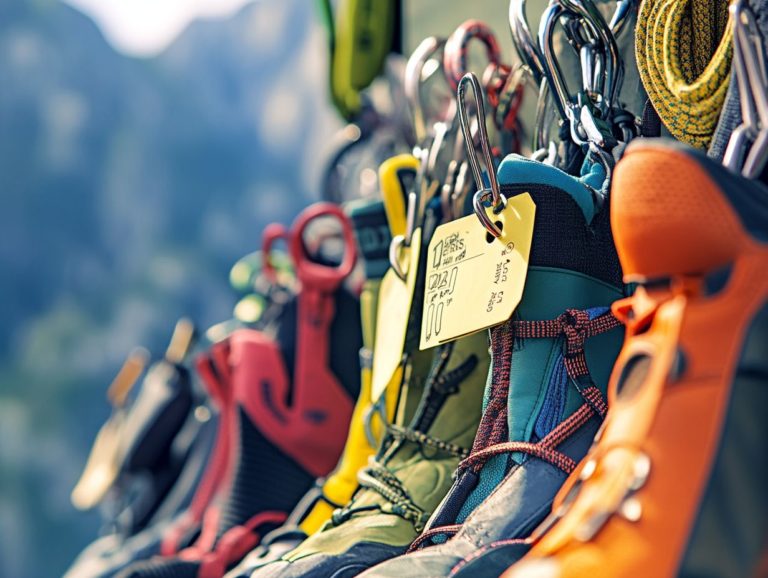How to Pack Your Climbing Gear Efficiently
Climbing adventures can be exhilarating, but the right gear is crucial it can mean the difference between a successful ascent and a challenging experience. Get ready to gear up for your next thrilling adventure!
This guide provides insights into essential climbing equipment and practical packing strategies designed specifically for various climbing styles.
From must-have items to clever organization tips, you’ll discover how to maximize space and minimize weight. This ensures you’re well-prepared for any climb.
You ll also learn effective ways to transport and protect your gear, keeping everything secure for the journey ahead.
Contents
- Key Takeaways:
- Essential Gear for Climbing
- Organizing Your Gear
- Packing for Different Types of Climbing
- Considerations for Sport, Trad, and Multi-Pitch Climbing
- Maximizing Space and Weight
- Transporting and Protecting Your Gear
- Frequently Asked Questions
- What are the essential gear items for packing for a climbing trip?
- How should I organize my gear when packing for a climbing trip?
- What is the best way to pack a climbing rope?
- How can I save space when packing my climbing gear?
- Should I pack any emergency gear for a climbing trip?
- What are some packing tips for a multi-day climbing trip, especially for alpine rock climbing?
Key Takeaways:
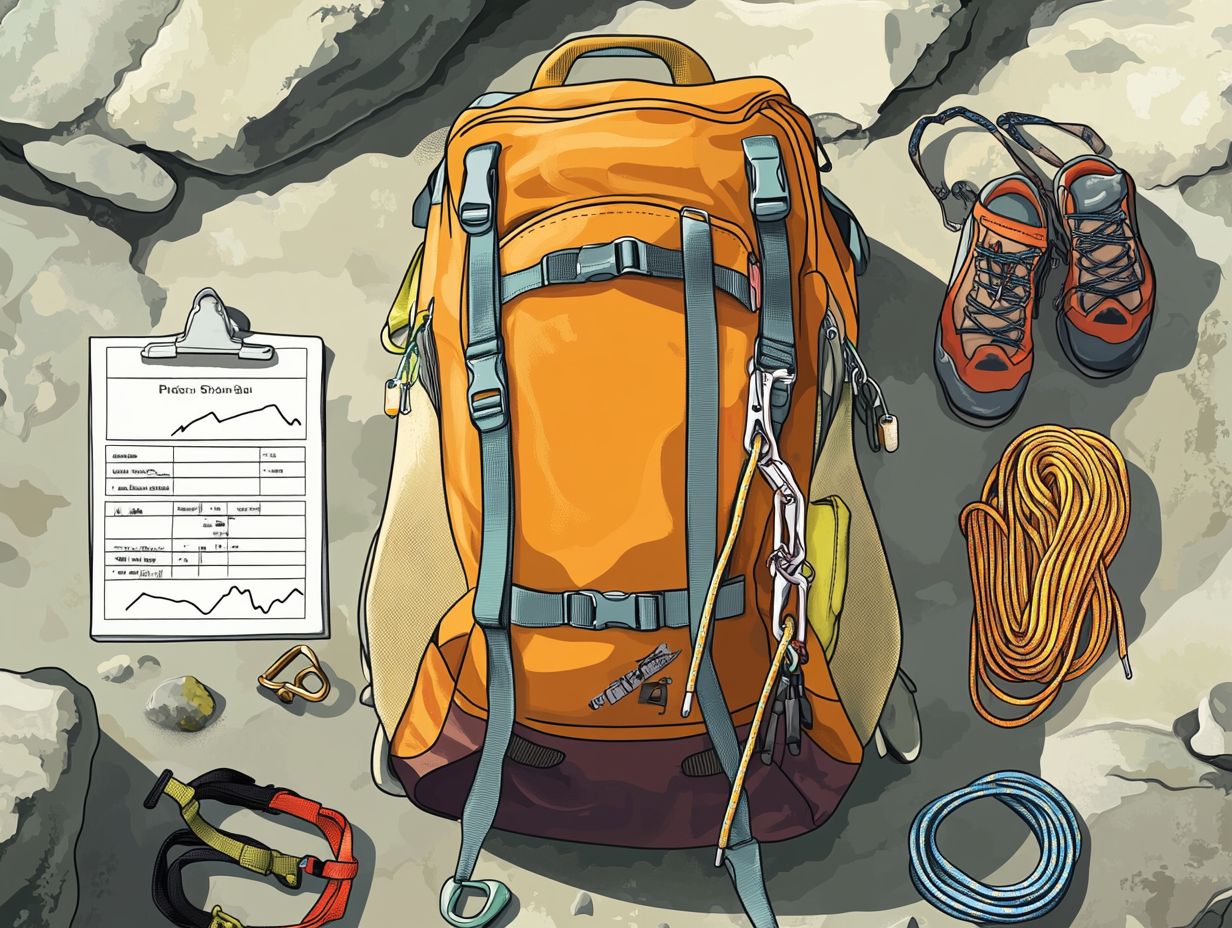
- Always pack essential gear first, such as your harness, ropes, and shoes, when preparing for a climb.
- Organize your gear by type and size to maximize space and easily access items during the climb.
- When packing for different types of climbing, consider the specific gear you need for each, like quickdraws for sport climbing (which help attach your rope to the rock) and cams for trad climbing (which secure into cracks).
Essential Gear for Climbing
When you prepare for your climbing adventures, having the right gear is crucial for both efficiency and safety. This allows you to focus on your performance and enjoyment, rather than worrying about what you might have left behind.
Here s the essential gear you need:
- A reliable climbing pack to carry everything
- Durable climbing shoes that fit well
- A first-aid kit for emergencies
- A water bottle to keep you hydrated
Top brands like Black Diamond provide specialized gear that enhances your climbing experience by ensuring easy access to equipment and optimizing your performance.
Must-Have Items for Any Climb
Every climber, whether just starting out or seasoned, should equip themselves with key items for any climb. This includes a sturdy helmet for safety, comfortable climbing shoes to enhance performance, and key accessories that elevate the experience.
When facing the diverse challenges of climbing, having the right packing essentials is crucial. For instance, knowing how to properly clean your climbing gear can help maintain its performance. Lightweight packs that distribute weight evenly can significantly enhance your endurance on long ascents.
A versatile harness, complemented by carabiners (which clip and secure your gear) and protection gear, establishes a secure anchor. This provides you with peace of mind as you tackle the heights. Don t forget extra layers for varying weather conditions they ll keep you comfortable and focused throughout your journey.
Recognizing the importance of gear management not only boosts your performance but also prioritizes safety, ensuring that every ascent is both enjoyable and challenging.
Organizing Your Gear
Organizing your gear effectively is essential for any climbing trip. It optimizes your gear management and enhances your efficiency during climbs, ensuring that you can access your essentials precisely when you need them most.
Tips for Efficient Packing
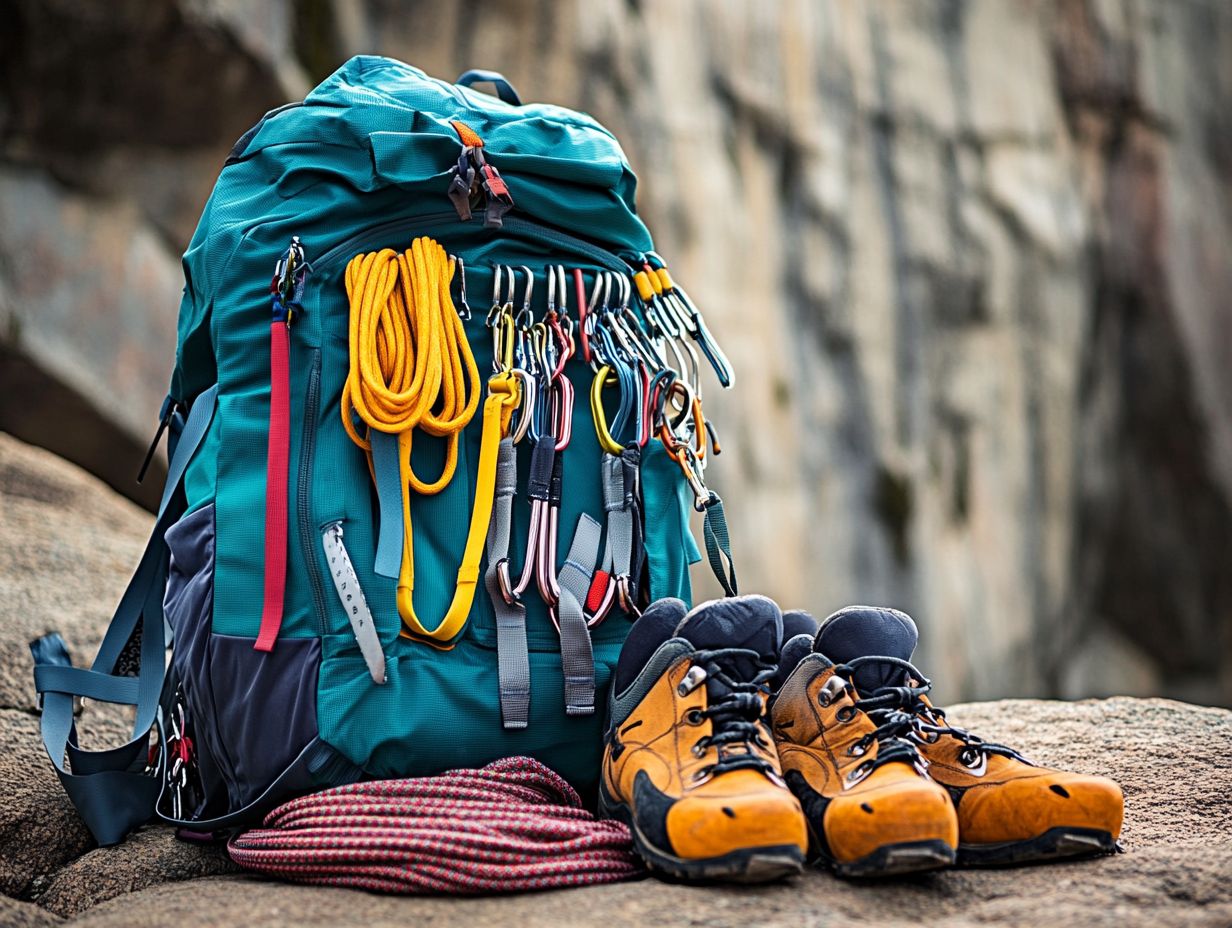
For efficient packing on your climbing trips, being thoughtful about your essentials can drastically reduce your pack weight and elevate your overall experience, allowing for a fast and light approach.
By prioritizing lightweight gear and cutting out unnecessary items, you can enhance your agility and stamina on challenging routes. Additionally, reviewing top tips for caring for your climbing gear is crucial to evaluate each piece of equipment critically, weighing its functionality against its weight.
For example, choosing multi-use tools can help minimize bulk while still addressing various tasks. Positioning heavier items closer to your back and using compression sacks (which help compress your gear and save space) can optimize balance and comfort.
Ultimately, keeping your pack weight in check not only boosts your climbing performance but also enhances safety, enabling you to stay agile and alert in demanding environments.
Packing for Different Types of Climbing
When you re preparing for various types of climbing be it sport, trad, or multi-pitch it s crucial to carefully consider the specific gear requirements and techniques tailored to the unique challenges each climbing route presents.
Considerations for Sport, Trad, and Multi-Pitch Climbing
When engaging in sport climbing, trad climbing, or multi-pitch endeavors, each style demands unique considerations regarding climbing gear, navigation, and the techniques needed for a successful ascent.
In sport climbing, fixed anchors, like bolts, simplify your gear requirements significantly. In contrast, trad climbing relies on natural features for protection placements. For trad climbers, a comprehensive rack of nuts and cams is essential for fall safety.
When it comes to multi-pitch climbing, finding the right balance is crucial! Equip yourself with gear for placing protection while managing rope systems that allow for efficient movement between pitches. Additionally, learning how to pack your survival gear efficiently can enhance your climbing experience.
Navigation skills are vital across all three styles. Sport climbers typically depend on established routes, while trad climbers need to hone their route-finding abilities. If tackling multi-pitch climbs, being aware of both climbing and descent paths is essential for safety throughout your journey.
Understanding the unique safety measures required for each style enhances your overall performance and ensures a safe climbing experience.
Maximizing Space and Weight
Maximizing space and weight when packing for climbing is crucial for navigating your routes with ease. Focus on strategies that promote lighter, more compact packing while keeping essential climbing gear easily accessible.
This approach improves your climbing experience and elevates your overall performance on the rock. For more tips, check out how to pack your outdoor accessories efficiently.
Strategies for Lighter and More Compact Packing
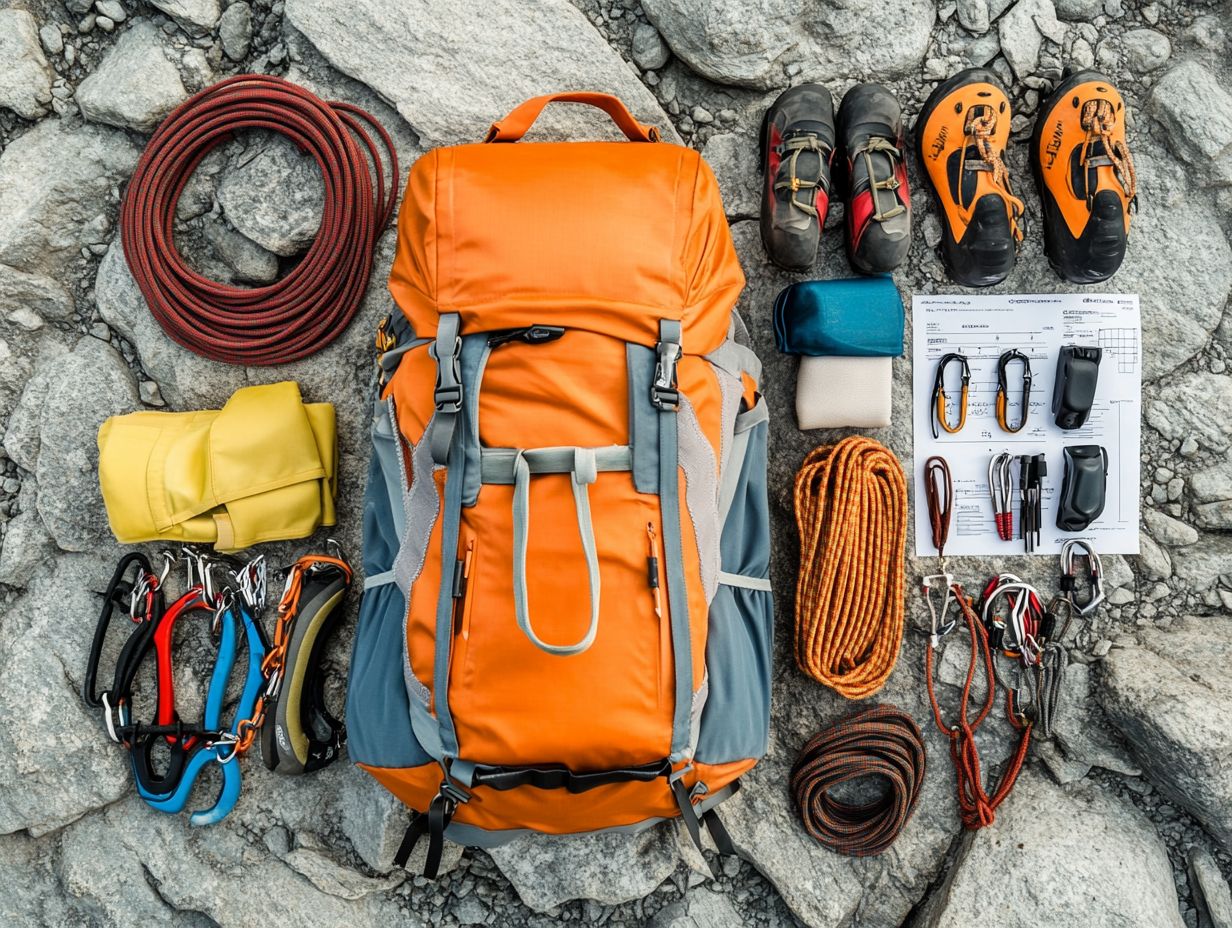
Using a lightweight pack with durable fabric significantly enhances your climbing experience by streamlining gear management. It allows for lighter, more compact packing.
Careful consideration of materials and designs ensures that your choice supports both your weight goals and the overall functionality of your gear. Select gear that connects easily, like modular systems (gear that can easily attach and detach), to maximize space while minimizing bulk. For additional tips, check out this guide on how to pack your outdoor accessories efficiently.
Choosing durable fabrics enhances the longevity and integrity of your gear, ensuring it withstands outdoor adventures. This thoughtful approach lets you focus on the journey ahead rather than the weight of your load, ultimately enhancing your performance and enjoyment during the climb.
Transporting and Protecting Your Gear
Transporting and safeguarding your climbing gear is essential for its longevity and peak performance. You have various options for carrying and storing equipment, including crag packs, rope bags, and alpine packs, all designed with durability and accessibility in mind.
Best Ways to Carry Your Climbing Gear
Crag packs, rope bags, and specialized climbing bags provide versatile options for carrying and storing your gear, making it easier to access equipment during your outdoor climbing adventures.
Each climbing bag type meets specific needs. For example, crag packs are ideal for short approaches, often featuring multiple compartments to keep your harness, quickdraws, and other essentials organized. In contrast, rope bags protect your climbing ropes from dirt and moisture, ensuring they remain durable in various conditions. Specialized climbing bags, like hydration packs, also cater to your hydration needs while shielding important gear from the elements. For those planning hikes, knowing how to pack a backpack for hiking is crucial to maximizing your outdoor experience.
By carefully selecting the right bag, you can elevate your outdoor experience.
Frequently Asked Questions
What are the essential gear items for packing for a climbing trip?
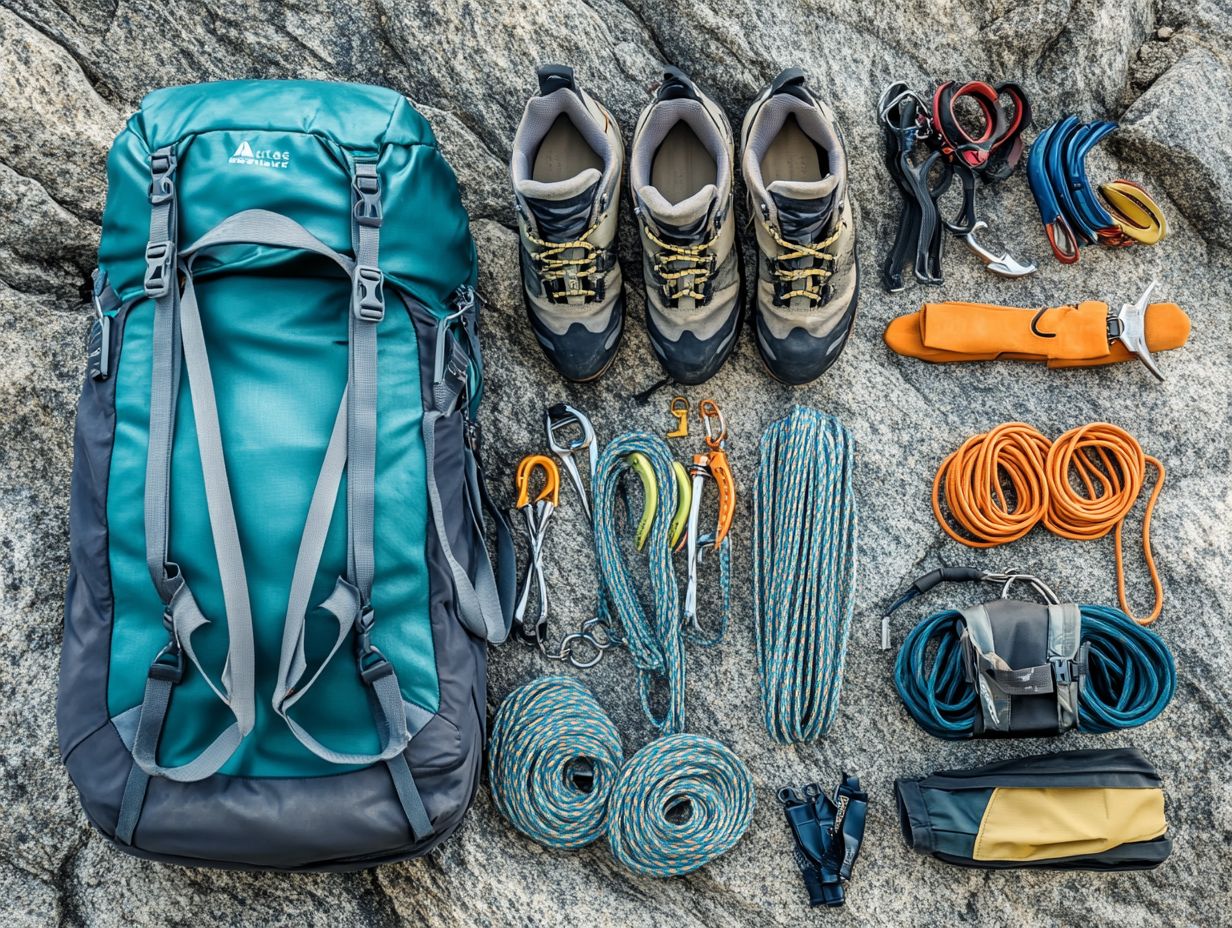
Essential gear for your climbing trip includes a climbing rope, harness, helmet, climbing shoes, quickdraws, carabiners, a chalk bag, and a belay device (used for controlling the rope during climbing).
How should I organize my gear when packing for a climbing trip?
You ll want to organize your gear efficiently. Group similar items together, like carabiners in one bag and quickdraws in another, to quickly find what you need.
What is the best way to pack a climbing rope?
Flake out the climbing rope on the ground to remove tangles and knots. Then, roll it up carefully and store it in a rope bag or backpack to prevent damage.
How can I save space when packing my climbing gear?
Use compression sacks for bulky items like your sleeping bag or extra clothes. You can also clip carabiners to the outside of your pack to hold smaller items, freeing up space inside.
Should I pack any emergency gear for a climbing trip?
Absolutely! Pack a first aid kit, emergency shelter, and a headlamp in case you get caught on the mountain longer than expected.
What are some packing tips for a multi-day climbing trip, especially for alpine rock climbing?
Pack items logically: keep daytime essentials on top and evening gear at the bottom. Also, stash snacks and water in easy-to-reach pockets to keep your energy up during the climb.

